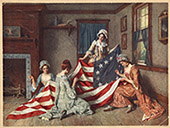Libraries, University of Nebraska-Lincoln
Document Type
Archival Material
Date of this Version
1904
Citation
BOSTON AND NEW YORK, HOUGHTON MIFFLIN COMPANY
NINETEENTH IMPRESSION, FEBRUARY, 1930
Abstract
FROM the moment when, through the courtesy of my friend Barrett Wendell, I came first to know Mr. Henry Adams's book, MontSaint- Michel and Chartres, I was profoundly convinced that this privately printed, jealously guarded volume should be withdrawn from its hiding-place amongst the bibliographical treasures of collectors and amateurs and given that wide publicity demanded alike by its intrinsic nature and the cause it could so admirably serve. To say that the book was a revelation is inadequately to express a fact; at once all the theology, philosophy, and mysticism, the politics, sociology, and economics, the romance, literature, and art of that greatest epoch of Christian civilization became fused in the alembic of an unique insight and precipitated by the dynamic force of a personal and distinguished style.
In this, and for once, his judgment is at fault. Mont-Saint-Michel and Chartres is one of the most distinguished contributions to literature and one of the most valuable adjuncts to the study of medirevalism America thus far has produced. The rediscovery of this great epoch of Christian civilization has had issue in many and valuable works on its religion, its philosophy, its economics, its politics, and its art, but in nearly every instance, whichever field has been traversed has been considered almost as an isolated phenomenon, with insufficient reference to the other aspects of an era that was singularly united and at one with itself. Hugh of Saint Victor and Saint Thomas Aquinas are fully comprehensible only in their relationship to Saint Anselm, Saint Bernard, and the development of Catholic dogma and life; feudalism, the crusades, the guilds and communes weave themselves into this same religious development and into the vicissitudes of crescent nationalities; Dante, the cathedral builders, the painters, sculptors, and music masters, all are closely knit into the warp and woof of philosophy, statecraft, economics, and religious devotion;-indeed, it may be said that the Middle Ages, more than any other recorded epoch of history, must be considered en bloc, as a period of consistent unity as highly emphasized as was its dynamic force.
Included in
American Studies Commons, Ancient, Medieval, Renaissance and Baroque Art and Architecture Commons, Architectural History and Criticism Commons, European Languages and Societies Commons, Fine Arts Commons



Comments
Copyright 1904. Introduction copyright 1913.
All public domain now.